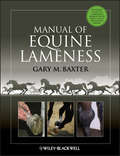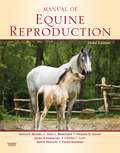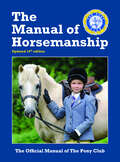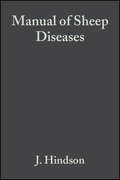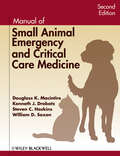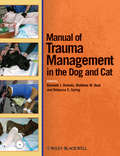- Table View
- List View
Manual of Equine Anesthesia and Analgesia
by Tom Doherty Alexander ValverdeIn recent years, a number of important developments have been made in equine anaesthesia and analgesia. These include new methods of monitoring the patient, the availability of new drugs and the implementation of new procedures. This book not only covers all the traditional methods of anaesthesia and recent developments, but it provides students and practitioners with essential information on the scientific basis of anaesthesia, as well as giving handy tips on more practical aspects of anaesthesia, such as drug regimens for field anaesthesia. Covers all the latest developments in equine anaesthesia whilst providing the reader with lots of practical information Includes detailed coverage of the sciences behind anaesthesia and the drugs used Easy-to-read format, with lots of bulleted lists and tabulated information
Manual of Equine Anesthesia and Analgesia
by Tom Doherty Alexander Valverde Rachel A. ReedA fully updated new edition of this practical guide to managing anesthesia in horses and other equids, providing updated and expanded information in a concise, easy-to-read format Manual of Equine Anesthesia and Analgesia provides practitioners and veterinary students with concise, highly practical guidance to anesthetizing horses, donkeys, and mules. Using a bulleted quick-reference format, this popular resource covers the basic physiological and pharmacological principles of anesthesia, patient preparation and monitoring, and the management of sedation and anesthesia. Chapters written by leading veterinary anesthesiologists contain numerous clinical images and illustrations, case examples, tables, diagrams, and boxed summaries of important points. Now in full color, the second edition features extensively revised and updated information throughout. New sections cover chronic pain, management of horses undergoing MRI, ventilators, nerve blocks for reproductive surgery, muscle relaxants, various new drugs, paravertebral anesthesia, treatment of pain using acupuncture and physical rehabilitation techniques, and more. Up-to-date appendices contain drug lists and dosages as well as equations related to equine cardiovascular and respiratory systems. This concise, easy-to-follow guide: Provides practical, clinically oriented information on anesthetizing equids Uses a bulleted format designed for fast access of key information Offers step-by-step instructions and diagrams of nerve blocks of the limbs, head, and ophthalmic structures Includes new coverage of topics including regulation of extracellular fluid and blood pressure, acid-base disorders, and hemodynamic effects of autonomic drugs Manual of Equine Anesthesia and Analgesia, Second Edition, remains a must-have resource for all equine practitioners and veterinary students involved with anesthetizing horses.
Manual of Equine Dermatology
by Dr Rosanna MarsellaThis book deals exclusively with the equine dermatological problems that the clinician would see in practice. It is the perfect reference for the practitioner who must quickly diagnose and treat the problems. Illustrated in color throughout, coverage progresses from the approach to a case which covers history, signalment, identification of primary vs secondary lesions, distribution of lesions, with examples of differential diagnoses based on the detection of specific lesions to therapy and to chapters of diseases organized by presenting problems and signs - pruritus, allergy, parasitic, crusting, nodules, ulcerative and regional. Over 90 color images together with tables and flow charts provide quick access to important diagnostic and treatment information.
Manual of Equine Lameness
by Gary M. BaxterManual of Equine Lameness provides essential information on equine lameness diagnostics and treatment in an easy-to-use format ideal for the clinical setting. A clinically relevant distillation of topics from Adams and Stashak's Lameness in Horses, this text offers a quick introduction and fast access to key information. An accompanying DVD includes practical supplements, including additional anatomical images, video clips demonstrating key procedures such as perineural and intrasynovial injections, and examples of lameness conditions in motion. Designed for use in daily practice, the book is presented in brief chapters carefully formatted to maximize the usefulness for practicing veterinarians. Manual of Equine Lameness is an invaluable resource to any veterinarian treating lameness in horses and an ideal reference for veterinary students wanting to learn the fundamentals of lameness.
Manual of Equine Lameness
by Gary M. BaxterManual of Equine Lameness provides essential information on equine lameness diagnostics and treatment in an easy-to-use format ideal for the clinical setting. A clinically relevant distillation of topics from Adams and Stashak's Lameness in Horses, this text offers a quick introduction and fast access to key information. An accompanying DVD includes practical supplements, including additional anatomical images, video clips demonstrating key procedures such as perineural and intrasynovial injections, and examples of lameness conditions in motion. Designed for use in daily practice, the book is presented in brief chapters carefully formatted to maximize the usefulness for practicing veterinarians. Manual of Equine Lameness is an invaluable resource to any veterinarian treating lameness in horses and an ideal reference for veterinary students wanting to learn the fundamentals of lameness.
Manual of Equine Lameness
by Gary M. BaxterMANUAL OF EQUINE LAMENESS Discover a concise and accessible guide to diagnosing and managing lameness in horses The revised Second Edition of Manual of Equine Lameness offers a concise and accessible manual of lameness diagnosis and treatment in horses. Perfect for use as a quick reference, this book provides straightforward access to the essentials of equine lameness, including the clinical assessment of the horse and commonly performed diagnostic nerve blocks and the most common conditions of the foot, forelimb, and hindlimb that may be contributing to the lameness. Current therapeutic options to treat lameness are also discussed, as well as guidance on how to manage musculoskeletal emergencies. The content has been distilled from the authoritative Seventh Edition of Adams and Stashak’s Lameness in Horses, and this new edition has been re-envisioned to be even quicker and easier to navigate than the previous version. Color photographs and illustrations support the text, which presents lameness information most relevant to equine general practitioners, mixed animal practitioners, and veterinary students. A companion website offers videos that focus on the clinical examination of the horse and select diagnostic blocks and relevant anatomy. Diagnostic and treatment material has been revised from the previous edition to include the most up-to-date information. Readers will find: A thorough introduction to the assessment of the lame horse, including history, visual exam, palpation, subjective and objective assessments of lameness, perineural anesthesia, and intrasynovial anesthesia An exploration of common conditions of the foot, including the navicular region and soft tissue injuries, coffin joint and distal phalanx conditions, and laminitis Discussions of the most common conditions of the forelimb, including the pastern, fetlock, metacarpus/metatarsus, carpus, antebrachium, elbow, and humerus, as well as the shoulder and scapula Discussions of common conditions of the hindlimb and axial skeleton A review of therapeutic options to treat lameness conditions How to manage musculoskeletal emergencies in the horse Ideal for veterinary students, early career equine practitioners, and mixed animal veterinarians, the Second Edition of Manual of Equine Lameness is an indispensable reference for any veterinarian seeking a concise one-stop reference for equine lameness.
Manual of Equine Lameness
by Gary M. BaxterMANUAL OF EQUINE LAMENESS Discover a concise and accessible guide to diagnosing and managing lameness in horses The revised Second Edition of Manual of Equine Lameness offers a concise and accessible manual of lameness diagnosis and treatment in horses. Perfect for use as a quick reference, this book provides straightforward access to the essentials of equine lameness, including the clinical assessment of the horse and commonly performed diagnostic nerve blocks and the most common conditions of the foot, forelimb, and hindlimb that may be contributing to the lameness. Current therapeutic options to treat lameness are also discussed, as well as guidance on how to manage musculoskeletal emergencies. The content has been distilled from the authoritative Seventh Edition of Adams and Stashak’s Lameness in Horses, and this new edition has been re-envisioned to be even quicker and easier to navigate than the previous version. Color photographs and illustrations support the text, which presents lameness information most relevant to equine general practitioners, mixed animal practitioners, and veterinary students. A companion website offers videos that focus on the clinical examination of the horse and select diagnostic blocks and relevant anatomy. Diagnostic and treatment material has been revised from the previous edition to include the most up-to-date information. Readers will find: A thorough introduction to the assessment of the lame horse, including history, visual exam, palpation, subjective and objective assessments of lameness, perineural anesthesia, and intrasynovial anesthesia An exploration of common conditions of the foot, including the navicular region and soft tissue injuries, coffin joint and distal phalanx conditions, and laminitis Discussions of the most common conditions of the forelimb, including the pastern, fetlock, metacarpus/metatarsus, carpus, antebrachium, elbow, and humerus, as well as the shoulder and scapula Discussions of common conditions of the hindlimb and axial skeleton A review of therapeutic options to treat lameness conditions How to manage musculoskeletal emergencies in the horse Ideal for veterinary students, early career equine practitioners, and mixed animal veterinarians, the Second Edition of Manual of Equine Lameness is an indispensable reference for any veterinarian seeking a concise one-stop reference for equine lameness.
Manual of Equine Nutrition and Feeding Management
by Carol Z. Buckhout Barbara E. LindbergManual of Equine Nutrition and Feeding ManagementS A practical manual for applied labs on the nutrition and feeding of horses In the Manual of Equine Nutrition and Feeding Management, a team of equine nutritionists and educators delivers a comprehensive manual perfect for use in an applied laboratory setting. This book explores critical ideas in equine nutrition, from plant identification to determining the cost of feeding. The laboratory concepts and assignments contained within this book combine the practical aspects of feeds and feeding with the technical aspects of equine nutrition. Each chapter is organized to include an introduction, objectives, and questions for further study; and is supplemented with additional activities to aid in the retention of the presented material. A companion website provides worksheets, with an instructor key with answers to the lab activities and assignments available to instructors. The book also includes: A thorough introduction to the equine digestive system, including the primary and secondary organs of digestion Comprehensive explorations of plant identification, pasture, hay, and concentrates for horses Practical discussions of by-product feeds and additives, including explanations of the concepts of “as sampled” and “dry matter” In-depth examinations of how to determine the nutrient content of feeds and the use of feeding standards and English-metric conversions Ideal for pre-veterinary and equine studies students, the Manual of Equine Nutrition and Feeding Management is also an indispensable resource for veterinary medicine and veterinary technician students, equine nutritionists, and the owners and breeders of horses.
Manual of Equine Nutrition and Feeding Management
by Carol Z. Buckhout Barbara E. LindbergManual of Equine Nutrition and Feeding ManagementS A practical manual for applied labs on the nutrition and feeding of horses In the Manual of Equine Nutrition and Feeding Management, a team of equine nutritionists and educators delivers a comprehensive manual perfect for use in an applied laboratory setting. This book explores critical ideas in equine nutrition, from plant identification to determining the cost of feeding. The laboratory concepts and assignments contained within this book combine the practical aspects of feeds and feeding with the technical aspects of equine nutrition. Each chapter is organized to include an introduction, objectives, and questions for further study; and is supplemented with additional activities to aid in the retention of the presented material. A companion website provides worksheets, with an instructor key with answers to the lab activities and assignments available to instructors. The book also includes: A thorough introduction to the equine digestive system, including the primary and secondary organs of digestion Comprehensive explorations of plant identification, pasture, hay, and concentrates for horses Practical discussions of by-product feeds and additives, including explanations of the concepts of “as sampled” and “dry matter” In-depth examinations of how to determine the nutrient content of feeds and the use of feeding standards and English-metric conversions Ideal for pre-veterinary and equine studies students, the Manual of Equine Nutrition and Feeding Management is also an indispensable resource for veterinary medicine and veterinary technician students, equine nutritionists, and the owners and breeders of horses.
Manual of Equine Reproduction - E-Book
by Steven P. Brinsko Terry L. Blanchard Dickson D. Varner James Schumacher Charles C. LoveNow in full color, Manual of Equine Reproduction, 3rd Edition provides a comprehensive look at the reproductive management of horses, including management of stallions, pregnant mares, and neonatal foals. Expert authors use a concise, practical approach in discussing improved therapies and treatments in equine breeding. You’ll enhance your skills and knowledge with this book’s detailed coverage of techniques used in reproductive examination, breeding procedures, pregnancy diagnosis, foaling, and reproductive tract surgery.A clinical emphasis includes a step-by-step format of possible scenarios from conception to breeding management. Practical information includes topics such as breeding with transported cooled or frozen semen, and caring for the broodmare and newborn foal. The organization of material corresponds to the course of study in veterinary school, so you can find topics easily. Chapter objectives and study questions at the beginning of each chapter guide you through the material and provide clear learning goals. Evaluation of Breeding Records chapter covers the importance of breeding records, and how to use them to evaluate stallion performance and optimize fertility. References are listed at the end of each chapter for further research and study. Full-color photographs and illustrations clearly depict procedures, and all drawings have been redrawn and improved. NEW Assisted Reproductive Technology chapter goes beyond embryo transfer. Updated content includes the latest advances in therapies and treatments. New content is added to two chapters, Reproductive Physiology of the Nonpregnant Mare and Manipulation of Estrus in the Mare. Thorough coverage of every aspect of equine reproduction provides a strong foundation for success in veterinary practice, including a discussion of the use of GnRH-analog deslorelin (Ovuplant) to hasten ovulation; aseptic technique for endometrial biopsy; use of transabdominal ultrasonography, especially in early pregnancy; determination of fetal gender by transrectal ultrasonography; aspiration testicular biopsy using a spring-loaded biopsy instrument; and procedure for surgical embryo transfer.
Manual of Exotic Pet Practice - E-Book
by Mark Mitchell Thomas N. Tully Jr.The only book of its kind with in-depth coverage of the most common exotic species presented in practice, this comprehensive guide prepares you to treat invertebrates, fish, amphibians and reptiles, birds, marsupials, North American wildlife, and small mammals such as ferrets, rabbits, and rodents. Organized by species, each chapter features vivid color images that demonstrate the unique anatomic, medical, and surgical features of each species. This essential reference also provides a comprehensive overview of biology, husbandry, preventive medicine, common disease presentations, zoonoses, and much more. Other key topics include common health and nutritional issues as well as restraint techniques, lab values, drug dosages, and special equipment needed to treat exotics.Brings cutting-edge information on all exotic species together in one convenient resource.Offers essential strategies for preparing your staff to properly handle and treat exotic patients.Features an entire chapter on equipping your practice to accommodate exotic species, including the necessary equipment for housing, diagnostics, pathology, surgery, and therapeutics.Provides life-saving information on CPR, drugs, and supportive care for exotic animals in distress.Discusses wildlife rehabilitation, with valuable information on laws and regulations, establishing licensure, orphan care, and emergency care.Includes an entire chapter devoted to the emergency management of North American wildlife.Offers expert guidance on treating exotics for practitioners who may not be experienced in exotic pet care.
The Manual Of Horsemanship: The Official Manual Of The Pony Club (Pony Club Guide Ser.)
by Pony ClubThe Manual of Horsemanship is a complete basic guide to horsemanship and horse care, suitable for all ages and containing an amalgam of expert knowledge. Boasting numerous improved, updated features and enjoying its biggest overhaul in a decade, the manual has been comprehensively revised with an exciting new format and design. This new edition has been brought up to date by members of the Training Committee of The Pony Club to include major updates to the Bridle, Bitting and Additional Saddlery, Shoeing and Worm Control chapters. With The Training Scale now included, along with an addition of an extensive glossary of terms, the chapters within the book have been re-arranged and grouped into three themed sections Part One: The Horse, Part Two: The Rider and Riding and Part Three: Saddlery and Lorinery, which makes reading the manual more logical. New photographs, charts and diagrams feature throughout and the increase in page size to 270 x 200mm provides ease of reference.
Manual of Parrot Behavior
by Andrew LuescherThis authoritative reference, the first of its kind, is a necessary addition to the library of any practitioner or behaviorist who sees avain companion animals. Because of their beauty, intelligence, playfulness and ability in mimicry, parrots are the most widely kept companion birds. It is estimated that more than half of the psittacine cases presented to clinicians are the result of behavioral problems-problems inherent to captivity. Bringing together a host of international experts on avian behavior, Manual of Parrot Behavior explores the many facets of psittacine behavior, both normal and abnormal. The book not only provides readers with a solid understanding of the basic principles of psittacine behavior but also offers useful techniques of diagnosis and treatment for specific problems. Covers both normal and abnormal parrot behavior Offers practical techniques on diagnosis and treatment of behavior problems Written by a team of international experts on avian behavior A necessary addition to the library of any practitioner of behaviorist who sees avian companion animals
Manual of Sheep Diseases
by J. Hindson Agnes WinterThis revised and updated version of Outline of Clinical Diagnosis in Sheep now covers the whole field of diagnosis, treatment and prevention of diseases and poor production of sheep. It is aimed at the non-specialist veterinarian and fills a niche between the large, comprehensive books on sheep and the shorter texts aimed at farmers. It will also appeal to all those involved in sheep production, and is a valuable reference for veterinary students. A wide range of diseases and conditions is covered, together with important aspects of production such as lamb output and growth rates. New sections have been added on nutrition (which has a significant effect on all aspects of production), anaesthesia, vaccination programmes, and parasite control.
Manual of Skin Diseases of the Dog and Cat
by Sue PatersonManual of Skin Diseases of the Dog and Cat, Second Edition provides a valuable asset to the practice library for quick and easy reference on a busy day. Dealing with all common skin diseases in both the dog and the cat, particular attention is paid to the differences between the two species. Each chapter looks at a different type of skin disease with descriptions of clinical presentations and a guide for diagnostic tests for each. This book is a combined update of two of Sue Paterson’s books, Skin Diseases of the Dog and Skin Diseases of the Cat, into one volume for ease of reference. Particular emphasis is placed on those diagnostic techniques available to the veterinarian within a general practice environment Provides a practical approach to diagnosis and management Contains almost 500 color photographs of common and rare skin conditions
Manual of Small Animal Emergency and Critical Care Medicine
by Douglass K. Macintire Kenneth J. Drobatz Steven C. Haskins William D. SaxonManual of Small Animal Emergency and Critical Care Medicine, Second Edition presents essential information on common emergencies in small animals using a concise, practical outline format. Offering a thorough update to this classic reference, the new edition provides new chapters on orthopedic injuries and wound management, significant revisions to the treatment protocols, and expanded toxicology information, as well as new references and drug information. The book retains its logical division into two parts, the first covering initial stabilization and the second offering a systems approach to specific conditions. As in the previous edition, chapters are extensively indexed and cross-referenced to facilitate ease of use in emergency situations. With many formulas, tables, drug dosages, and illustrations, Manual of Small Animal Emergency and Critical Care Medicine is an indispensable, convenient resource for busy emergency clinicians, whether they are new graduates or seasoned professionals.
Manual of Small Animal Emergency and Critical Care Medicine
by Douglass K. Macintire Kenneth J. Drobatz Steven C. Haskins William D. SaxonManual of Small Animal Emergency and Critical Care Medicine, Second Edition presents essential information on common emergencies in small animals using a concise, practical outline format. Offering a thorough update to this classic reference, the new edition provides new chapters on orthopedic injuries and wound management, significant revisions to the treatment protocols, and expanded toxicology information, as well as new references and drug information. The book retains its logical division into two parts, the first covering initial stabilization and the second offering a systems approach to specific conditions. As in the previous edition, chapters are extensively indexed and cross-referenced to facilitate ease of use in emergency situations. With many formulas, tables, drug dosages, and illustrations, Manual of Small Animal Emergency and Critical Care Medicine is an indispensable, convenient resource for busy emergency clinicians, whether they are new graduates or seasoned professionals.
A Manual of the Mammalia: An Homage to Lawlor’s “Handbook to the Orders and Families of Living Mammals”
by Douglas A. Kelt James L. PattonThe taxonomy of recent mammals has lately undergone tremendous revision, but it has been decades since the last update to Timothy E. Lawlor’s acclaimed identification guide the Handbook to the Orders and Families of Living Mammals. Integrating the latest advances in research, Douglas A. Kelt and James L. Patton provide this long-overdue update in their new, wholly original work, A Manual of the Mammalia. Complemented by global range maps, high-resolution photographs of skulls and mandibles by Bill Stone, and the outstanding artwork of Fiona Reid, this book provides an overview of biological attributes of each higher taxon while highlighting key and diagnostic characters needed to identify skulls and skins of all recent mammalian orders and most families. Kelt and Patton also place taxa in their currently understood supra-familial clades, and discuss current challenges in higher mammal taxonomy. Including a comprehensive review of mammalian anatomy to provide a foundation for understanding all characters employed throughout, A Manual of the Mammalia is both a user-friendly handbook for students learning to identify higher mammal taxa and a uniquely comprehensive, up-to-date reference for mammalogists and mammal-lovers from across the globe.
A Manual of the Mammalia: An Homage to Lawlor’s “Handbook to the Orders and Families of Living Mammals”
by Douglas A. Kelt James L. PattonThe taxonomy of recent mammals has lately undergone tremendous revision, but it has been decades since the last update to Timothy E. Lawlor’s acclaimed identification guide the Handbook to the Orders and Families of Living Mammals. Integrating the latest advances in research, Douglas A. Kelt and James L. Patton provide this long-overdue update in their new, wholly original work, A Manual of the Mammalia. Complemented by global range maps, high-resolution photographs of skulls and mandibles by Bill Stone, and the outstanding artwork of Fiona Reid, this book provides an overview of biological attributes of each higher taxon while highlighting key and diagnostic characters needed to identify skulls and skins of all recent mammalian orders and most families. Kelt and Patton also place taxa in their currently understood supra-familial clades, and discuss current challenges in higher mammal taxonomy. Including a comprehensive review of mammalian anatomy to provide a foundation for understanding all characters employed throughout, A Manual of the Mammalia is both a user-friendly handbook for students learning to identify higher mammal taxa and a uniquely comprehensive, up-to-date reference for mammalogists and mammal-lovers from across the globe.
A Manual of the Mammalia: An Homage to Lawlor’s “Handbook to the Orders and Families of Living Mammals”
by Douglas A. Kelt James L. PattonThe taxonomy of recent mammals has lately undergone tremendous revision, but it has been decades since the last update to Timothy E. Lawlor’s acclaimed identification guide the Handbook to the Orders and Families of Living Mammals. Integrating the latest advances in research, Douglas A. Kelt and James L. Patton provide this long-overdue update in their new, wholly original work, A Manual of the Mammalia. Complemented by global range maps, high-resolution photographs of skulls and mandibles by Bill Stone, and the outstanding artwork of Fiona Reid, this book provides an overview of biological attributes of each higher taxon while highlighting key and diagnostic characters needed to identify skulls and skins of all recent mammalian orders and most families. Kelt and Patton also place taxa in their currently understood supra-familial clades, and discuss current challenges in higher mammal taxonomy. Including a comprehensive review of mammalian anatomy to provide a foundation for understanding all characters employed throughout, A Manual of the Mammalia is both a user-friendly handbook for students learning to identify higher mammal taxa and a uniquely comprehensive, up-to-date reference for mammalogists and mammal-lovers from across the globe.
A Manual of the Mammalia: An Homage to Lawlor’s “Handbook to the Orders and Families of Living Mammals”
by Douglas A. Kelt James L. PattonThe taxonomy of recent mammals has lately undergone tremendous revision, but it has been decades since the last update to Timothy E. Lawlor’s acclaimed identification guide the Handbook to the Orders and Families of Living Mammals. Integrating the latest advances in research, Douglas A. Kelt and James L. Patton provide this long-overdue update in their new, wholly original work, A Manual of the Mammalia. Complemented by global range maps, high-resolution photographs of skulls and mandibles by Bill Stone, and the outstanding artwork of Fiona Reid, this book provides an overview of biological attributes of each higher taxon while highlighting key and diagnostic characters needed to identify skulls and skins of all recent mammalian orders and most families. Kelt and Patton also place taxa in their currently understood supra-familial clades, and discuss current challenges in higher mammal taxonomy. Including a comprehensive review of mammalian anatomy to provide a foundation for understanding all characters employed throughout, A Manual of the Mammalia is both a user-friendly handbook for students learning to identify higher mammal taxa and a uniquely comprehensive, up-to-date reference for mammalogists and mammal-lovers from across the globe.
Manual of Trauma Management in the Dog and Cat
by Kenneth J. Drobatz Matthew W. Beal Rebecca S. SyringManual of Trauma Management in the Dog and Cat provides quick access to clinically relevant information on stabilizing, diagnosing, and managing the trauma patient. The book uses an outline format to provide fast access to essential information, focusing on practical advice and techniques for treating traumatic injuries. Manual of Trauma Management in the Dog and Cat is an ideal handbook for quickly and confidently managing this common presenting complaint. Beginning with a concise summary of the global assessment of traumatized patients, the heart of the book is devoted to guidance on managing specific types of trauma following definitive diagnosis. Manual of Trauma Management in the Dog and Cat is a valuable quick-reference guide to treating canine and feline trauma patients for general practitioners and emergency specialists alike.
Manual of Veterinary Transfusion Medicine and Blood Banking
by Kenichiro Yagi Marie HolowaychukUsing a practical approach, the Manual of Veterinary Transfusion Medicine and Blood Banking provides veterinary practitioners with evidence-based guidelines to refer to at the clinical practice level. Provides evidence-based information on transfusion medicine and blood banking practices Presents sections on recipient screening, donor selection, blood collection and storage, and how to meet blood product demands Includes useful protocols for transfusions and blood banking relevant to clinical practice Incorporates the balanced perspectives of veterinarians and veterinary technicians Contains information pertaining to large, small, and exotic animals
Manual of Veterinary Transfusion Medicine and Blood Banking
by Kenichiro Yagi Marie K. HolowaychukUsing a practical approach, the Manual of Veterinary Transfusion Medicine and Blood Banking provides veterinary practitioners with evidence-based guidelines to refer to at the clinical practice level. Provides evidence-based information on transfusion medicine and blood banking practices Presents sections on recipient screening, donor selection, blood collection and storage, and how to meet blood product demands Includes useful protocols for transfusions and blood banking relevant to clinical practice Incorporates the balanced perspectives of veterinarians and veterinary technicians Contains information pertaining to large, small, and exotic animals
Manual to Veterinary Video-Oto-Endoscopy: Use and Utility in Canine and Feline Ear Diseases
by Giovanni GhibaudoThis atlas provides a step-by-step manual in using the video-oto-endoscope (VOE) as a tool to study ear diseases in cats and dogs. Illustrated by numerous high-resolution images and case studies, the book explains in a highly accessible manner when and how to use VOE. It teaches how to differ between a normal and a pathological animal ear and guides the reader in diagnosing a particular disease. The book's main section provides in-depth information on causes, clinical picture, and imaging of ear diseases such as acute otitis externa, chronic otitis externa, and otitis media in small animals. Moreover, the atlas introduces technical fundamentals of the instrument and gives tips for its correct handling and cleaning. Further, readers are instructed on how to best prepare the animal patient for examination by VOE. The atlas addresses veterinary practitioners and veterinary technicians who are interested in performing otological examinations in cats and dogs.



